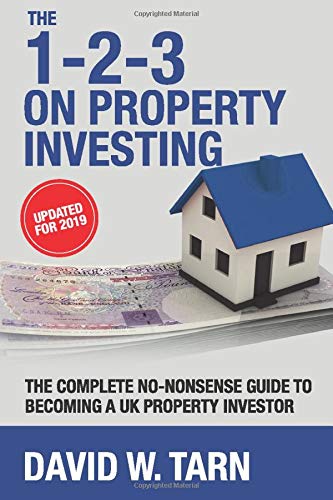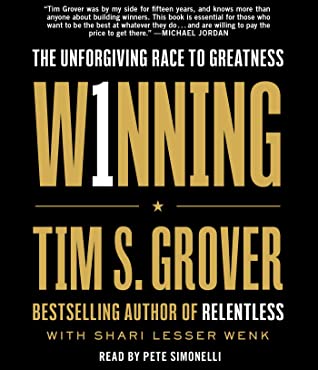The complete no-nonsense guide to becoming a UK property investor (REVIEW/SUMMARY)
Introduction
The complete, no-nonsense guide to becoming a UK property investor is the first book by property investor and entrepreneur David Tarn. After becoming interested in this form of investment, I came across the book on audible and decided to review its contents, in order to help you decide whether the book is right for you.

As well as my general opinion on the content of the book, I have also included a chapter by chapter summary, with the hope that you can become more informed and inspired in your own business/investment journey.
What I thought of the book
I am very glad I read this book. For anyone in the UK considering buying an investment property, this book is absolutely rammed full of crucial concise information. Every conceivable step necessary in the process is covered, all the way from deciding where to source property, right the way through to keeping tenants over the long term. I liked that years of trial and error has quite clearly gone into the knowledge contained within the book. I also appreciated the inspirational message at the beginning and end, leaving me feeling driven to take action in the investment world.
(You can click here to check out the reviews of the book on Amazon)
Chapter Summary
Part 1: GETTING STARTED
Chapter 1 – Assessing the avenues available to source property
“Listen to everyone, and follow no one”
Dean Karnazes
In this first chapter of the book, David Tarn clarifies the nature of property investment- whilst his methods have been successful for him and the advice he gives is sound, it is likely to vary from other investors who have also achieved success in this area. There is more than one way to skin a cat, and different property markets favour different investment strategies.
Furthermore, Tarn breaks down the different methods of sourcing property in detail in this first chapter. The different approaches discussed include:
- The Newspaper
- The estate agent (their window, website and phone line)
- The internet (sites like Rightmove or Zoopla)
- Property auctions
- Professional property sourcing companies
- Friends, family, colleagues, etc
- Landlord’s associations
- Leaflet distribution
- For Sale boards
Check out this introduction to UK property by the author, David Tarn:
Chapter 2 – Your Chosen Strategy
Tarn starts the chapter by talking through some of the factors which will ultimately affect your preferred investment strategy:
- Geographical location
- Reason for purchasing a property
- The amount of capital you have to invest
- Do you intend on investing in your local area, or are you going further afield?
- The risk to reward threshold
- The type of property you are buying
- Your returns
- Investor vs Landlord
Chapter 3 – Understanding returns on investments and yields
Yield takes 2 different forms- gross yield and net yield.
Gross yield is, simply, the amount of income a rental property generates, expressed as a percentage of the property value. (if a house is worth £100,000 and the rental income generated is £5000 per year, the gross yield would work out at 5%.
Net yield is a more extensive yield calculation, which takes into account all the costs of running the property. (mortgage, maintenance, insurance/agency fees, etc). Net yield is a more accurate way of predicting rental yield, and so is favoured by investors.
ROI means Return on investment, also known as ROCE or return on cash employed. To calculate the ROI, take the rent accrued over 1 year. Subtract the costs associated with running the property (Mortgage, management, fees), to come up with a net rental income figure. Now express this net rental income figure as a percentage of the total cost of purchasing and renovating (includes initial 25% deposit, solicitors fees, etc). You now have the amount of return you make per year on your initial cash investment, expressed as a percentage.
Read also: The Bitcoin Standard (review/summary)
Chapter 4 – 3 main types of financial strategies
The 3 main types of financial strategies discussed in this chapter are:
- Use your own money to fund the entire purchase
- Use your own money, coupled with leverage
- Use other peoples money or joint venture
Tarn goes in-depth about each option and its various intricacies, in order to help you better understand how you might best go about implementing your own financial strategy.
Chapter 5 – Interest only vs repayment mortgages
A repayment mortgage is where the full mortgage value, in addition to the interest, is repaid over the agreed time period (usually 20-25 years). On the last day of the mortgage period, you will make your last payment, owe nothing more to the mortgage company and own the property completely.
An interest-only mortgage is where only the interest on the mortgage is repaid on a monthly basis. At the end of the mortgage period, the full initial borrowed amount (typically 75% of the property value) is owed to the bank.
Repayment mortgages are typically preferred by the more cautious investor; those looking to build a portfolio slowly and steadily over the longer term. Whilst monthly payments are significantly higher, (in turn, reducing monthly cash flow dramatically), the fact that the house ends up completely paid for at the end of the mortgage period attracts many investors.
The interest-only approach is a faster, more aggressive and slightly higher risk process due to the lump sum that is owed at the end of your mortgage agreement. Monthly mortgage payments are clearly far lower, allowing cash to be accumulated much more quickly.
One major benefit of the interest-only mortgage is that you are actually using the power of inflation to pay down the value of your debt. (£100 in 25 years won’t be worth nearly as much to you as £100 is today!)
Interest-only mortgages are not something that I have ever considered personally, but tarn makes a strong case for them here and I have to say that I found this chapter very informative and impactful.
Chapter 6 – Refurb or not to refurb? That is the question
Tarn spends this chapter using in-depth, mathematical examples to demonstrate the basic financial differences between buying a property that needs work vs buying a property that is in good condition. A few interesting points made in this chapter include:
The buy-to-refurb market is more competitive than it has ever been. Whilst it was once straightforward to find a property that was being sold for significantly below its potential value due to the nature of work required, it is more and more becoming a real skill and the margins are being squeezed.
When you buy a house that needs significant work, there are not just the obvious costs of the building work that need to be considered. There is also the foregone rental income, resulting from all of the time that it takes to sort out the house. This is another cost that again squeezes out potential profits.
Tarn himself has a wide range of properties in his portfolio, and his deals are considered case by case. Nothing should ever be ruled out in property investment as the opportunity can be found anywhere. Ultimately, the most important thing to think about is the mathematics behind expected costs and profits.
Read also: Too cheap for therapy? Read these books!
Part 2: Purchasing property
Chapter 1 – Finding suitable properties
Tarn starts this chapter with an in-depth overview of all of the costs associated with buying a property (There is far more to consider than you might think!). He also stresses the importance of developing a genuine mutually beneficial relationship with the local estate agents.
Tarn also talks of certain clues that he personally looks out for when viewing properties. If you are looking for a property to renovate, look for properties with limited pictures on Rightmove or even just of the outside. Or look for tape across the taps and electrical sockets on a property, indicating they have been deemed unfit for use.
If a house on the market is empty and completely stripped of all furniture, this indicates that the former owner has already moved on and would be keen to sell the property quickly. If you are in a position to buy fast, you may be able to come in with a lower offer.
Many more little tricks like this, gained through the authors years in the property industry, are shared in this chapter.
Chapter 2 – Contacting the agents and viewing the property
Tarn talks here of the proper way to go about arranging viewings with agents, so that they feel respected and encouraged to work with you in the future. A serious, well-financed and knowledgeable property investor go about the business of property viewings very differently from the casual rookie.
Tarn then breaks down, in impressive detail, much of what he is looking for as he walks around to assess a property. Everything from the guttering and the roofline, to the carpets and the hinges. This is a man that has clearly walked around a lot of houses!
Chapter 3 – Offering and negotiating
“The fundamental advice here is to only offer on a property if you intend to honour the purchase, and only when you have the funds available, or you are certain that they will be available”
A lot of this comes back again to respecting the time and intention of the agent, to allow for the growth of a prosperous long term mutually beneficial relationship.
“It is my current opinion, looking at a somewhat flooded market, that it would be in your advantage to spend an extra few grand on a great property, rather than to squeeze a few extra grand on an average property”
Chapter 4 – The financials
The following quotation sums up this chapter’s content:
“This chapter will give you a full insight and make clear the costs associated with purchasing a property. I intend to walk you through an entire purchase, with regard to the financials, starting with your broker and finishing with the final payment to your solicitor”
Chapter 5 – The purchasing procedure
“I dont think I have ever been through the same process twice with this. Seriously. There seems to be, every time, with every lender, with every solicitor, every sale, a different approach”
Given this case by case variation in purchase procedures, Tarn uses this chapter to explain what is typically expected of you by solicitors and agents when buying a property in the UK.
What struck me about the content of this chapter was the sheer amount of hoops that need to be jumped through in order to just buy a house. He actually lists a typical process, and there are 19 steps!
check out this beginners guide to buy to let property investment in the UK:
Part 3: Letting and managing the property
Chapter 1 – The first step
Tarn starts this chapter with the following distinction. If your property is clean, organised, homely and generally desirable, you will have the luxury of picking your tenants. If your property is dirty, smelly, unorganised or generally undesirable, your tenants will be the ones picking you.
The author then walks us through the very first steps that need to be taken once the keys have been collected. Everything from setting the heating on an intermittent timer so that the house (absolutely uninhabited) doesn’t lose its residual heat- to the importance of buying a professionally made TO LET sign that sends the right message about you as a landlord. It is all of these small steps, that you wouldn’t necessarily think of at first, ultimately portray your property and you in the best possible light to potential tenants.
Chapter 2 – Where to advertise, and at what price?
Tarn begins this chapter by summarising the property management process. His explanation includes:
- Advertising the property through your chosen portals
- Exactly what to include in the description of your advertisement
- Great photos and their importance
- His preferred means of communication with prospective tenants
- Including as much information as possible about your ideal prospective tenants. (By using phrases like “Families preferred” or “No pets allowed”, you will avoid wasting time entertaining unsuitable prospects).
The author then compares different advertising portals, explaining his personal preferences and the different merits of different websites. Tarn provides the kind of insight clearly gained by trying to rent out a lot of houses online!
Read also: 9 People who stood up for what they believed in
Chapter 3 – Finding and vetting a tenant
“Most landlords go through the whole process of sourcing, buying and renovating with great care, only to let the property to the first tenant that shows an interest.”
“Every time someone asks me about a so-called nightmare tenant, my answer is always ‘no, not really”
The key point made in this chapter is the absolute importance of being patient when vetting tenants. If you can hold out and reject below ideal initial tenants, and your property is clean and desirable, eventually the right tenant will come along. If you can have the patience to hold out for the right tenant who fulfils all of your personal criteria, then many of the issues that landlords face can be almost completely avoided.
Think about it. You’ve spent tens of thousands of pounds on this project, is it really a problem if you miss out on two or three months rental income as a result of taking the time to find a reliable tenant?
Chapter 4 – Setting up the tenancy
“Setting up a tenancy used to be a relatively straightforward task, almost as simple as giving out a contract or AST. But these days, the world gone mad, the process is a slightly more complex one and can carry hefty fines if not adhered to correctly.”
Tarn provides a brief summary of the things to think about when setting up a tenancy but stresses the importance of case by case research as these are regulations that change constantly and differ from place to place.
Tarn also recommends the book Landlord Law by Tessa Shepperson. (You can click here to check out the Landlord Law website).
Chapter 5 – Keeping your tenants (+ Closing thoughts)
In this final chapter, Tarn speaks about the importance of keeping good tenants happy at all costs. As he points out, it is far easier to keep a reliable tenant happy than it is to find another one just like them.
When something breaks, you could consider it an inconvenience or factor it in as an unexpected cost. Or, you could see it as an opportunity to build trust with reliable tenants and keep them happy in your property for the long term. If you’ve got solid tenants who pay in full and on time with no qualms, they are well worth going out of your way for.
Tarns closing advice for people getting into property left an impression on me, and I feel it would be best to share it as a full quote.
“I have been asked by many people on many occasions over many years now, how have I been so successful in the industry in a relatively short time frame? Given that I started out without any financial backing or real capital to invest?… I tell them this. When sir Isaac Newton was asked how he discovered the laws of gravity, he simply replied ‘by thinking about it all the time’.”
If this book sounds like it might be for you, you can check it out here on amazon
Enjoyed this article? Check out some of our others:
What does it take to become a successful chef?






